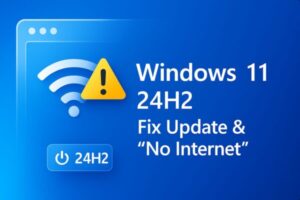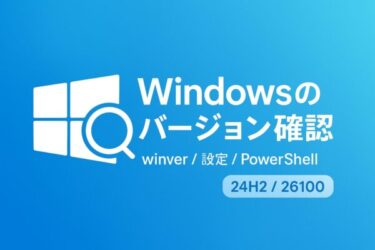
Seeing messages like “This version of Windows has reached end of service,” updates failing at 0–100%, or Wi-Fi that says “Connected, no internet”? You’re not alone. Since Windows 11 version 24H2 began rolling out, a noticeable number of users have reported update blocks, network glitches, and post-update instability. This guide collects the most effective, safe fixes you can try right now.
Last updated: Sep 2025
- 1 Before You Start
- 2 Quick Wins (Try These First)
- 3 Check Your Version & Channel
- 4 Fix Update Errors & “End of Service” Warnings
- 5 Fix “Connected, No Internet” After 24H2
- 6 Start Menu / Taskbar Not Responding
- 7 Full Shutdown vs. Restart (Why It Matters)
- 8 Clean Boot & Safe Mode (Conflict Check)
- 9 Roll Back or Defer (When You Must Work Now)
- 10 FAQ
- 11 If Nothing Works
Before You Start
- Back up important files (OneDrive/USB/SSD).
- Use an admin account.
- Connect AC power (laptops).
- Have your device model/BIOS version handy.
Quick Wins (Try These First)
- Restart once (applies pending updates), then try a Full Shutdown if the issue persists.
- Network Reset: Settings > Network & Internet > Advanced network settings > Network reset, then reboot.
- Windows Update Troubleshooter: Settings > System > Troubleshoot > Other troubleshooters > Windows Update.
- Temporarily disable VPN/AV, then retry the update (re-enable afterward).
Check Your Version & Channel
Press Win + R → type winver → Enter. The latest public release is 24H2. If you’re on 22H2/23H2 and can’t see 24H2, your device may be held due to compatibility, policy, or hardware blocks (CPU/TPM/Secure Boot).
Fix Update Errors & “End of Service” Warnings
1) Verify CPU / TPM 2.0 / Secure Boot
- TPM: Press
Win + R, runtpm.msc→ status should show “TPM is ready for use.” - Secure Boot: Check BIOS/UEFI > Boot/Security → set to Enabled (may require GPT/UEFI mode).
- CPU generation: Win + R > msinfo32 → note the processor, confirm it’s supported for Windows 11 24H2 (8th-gen Intel+ / Ryzen 2000+ are typical baselines; some very old CPUs are blocked).
Tip: Microsoft’s “PC Health Check” shows a simple pass/fail for 24H2 readiness.
2) Repair System Files (Safe & Reversible)
Open Command Prompt (Admin) and run:
DISM /Online /Cleanup-Image /RestoreHealth sfc /scannowLet DISM finish (10–30 min), then run SFC. Reboot and try Windows Update again.
3) Reset Windows Update Cache (Non-destructive)
- Open Services (
services.msc) → stop Windows Update and BITS. - Rename the cache folder:
C:\Windows\SoftwareDistribution→SoftwareDistribution.old. - Start Windows Update and BITS again, reboot, and retry.
4) In-Place Upgrade (Keeps Files & Apps)
Download the Windows 11 Installation Assistant or 24H2 ISO from Microsoft, run setup.exe, and choose Keep personal files and apps. This refreshes system components without wiping your data.
Fix “Connected, No Internet” After 24H2
- Set DNS manually: Google (8.8.8.8 / 8.8.4.4) or Cloudflare (1.1.1.1 / 1.0.0.1). Settings > Network & Internet > Wi-Fi/Ethernet > Properties > DNS > Manual.
- Network Reset (see “Quick Wins”).
- Update/Rollback Wi-Fi driver: Device Manager > Network adapters → your adapter → Update driver or Roll Back Driver if the problem started after 24H2.
- Temporarily uninstall VPN (Nord/Express/etc.) and retest; reinstall latest version later.
More details in our network guide: Wi-Fi connected but no internet.
Start Menu / Taskbar Not Responding
- Full Shutdown: try once (Shift + click Shut down) or disable Fast Startup temporarily.
- Restart Explorer: Ctrl + Shift + Esc → Task Manager → Windows Explorer → Restart.
- New user profile: create a fresh local account and test—helps isolate profile corruption.
See our deep-dive: Start menu / taskbar not responding.
Full Shutdown vs. Restart (Why It Matters)
On Windows 10/11, a normal “Shut down” may use Fast Startup (hybrid hibernation), which can preserve kernel/driver state and accidentally carry minor glitches forward. A Restart always reinitializes cleanly. If a restart doesn’t help, do a Full Shutdown (Shift + Shut down) or turn Fast Startup off temporarily. Learn more here: Complete Shutdown (Cold Boot).
Clean Boot & Safe Mode (Conflict Check)
- Clean Boot: run
msconfig→ Services tab → check “Hide all Microsoft services” → Disable all; Startup tab → Open Task Manager → disable all. Reboot and test update. - Safe Mode: Settings > System > Recovery > Advanced startup → Restart now → Troubleshoot → Advanced options → Startup Settings → Restart → choose 4 (Safe Mode). Try uninstalling a problematic update or driver.
Roll Back or Defer (When You Must Work Now)
- Go back: Settings > System > Recovery > Go back (available for ~10 days after a feature update).
- Pause updates: Settings > Windows Update → Pause for a week (repeat to extend up to 35 days).
FAQ
Q. Why does my update say “end of service” even though I’m on Windows 11?
A. It refers to your version (e.g., 22H2/23H2), not the edition. Install the latest feature update (24H2) when your device is ready.
Q. Is my CPU the reason 24H2 won’t install?
A. Possibly. Very old Intel/AMD processors may be blocked for security/feature reasons. Check CPU generation, TPM 2.0 and Secure Boot.
Q. Will a Full Shutdown erase my files?
A. No. It only affects how Windows powers off/initializes. Save open work first.
If Nothing Works
- Update BIOS/UEFI to the latest version from your device maker.
- Perform an in-place upgrade using the 24H2 ISO (keeps apps/files).
- As a last resort, back up and perform a clean install.
For ongoing known issues and workarounds, see our compilations: Windows 11 24H2 issues & mitigations.


